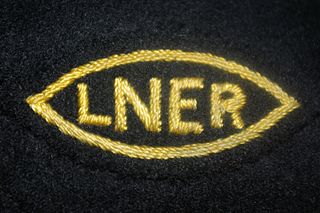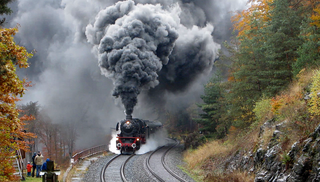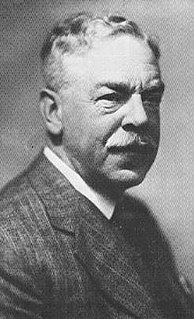
Sir Herbert Nigel Gresley was a British railway engineer. He was one of Britain's most famous steam locomotive engineers, who rose to become Chief Mechanical Engineer (CME) of the London and North Eastern Railway (LNER). He was the designer of some of the most famous steam locomotives in Britain, including the LNER Class A1 and LNER Class A4 4-6-2 Pacific engines. An A1 Pacific, Flying Scotsman, was the first steam locomotive officially recorded over 100 mph in passenger service, and an A4, number 4468 Mallard, still holds the record for being the fastest steam locomotive in the world (126 mph).
The London and North Eastern Railway (LNER) produced several classes of locomotive, mostly to the designs of Nigel Gresley, characterised by a three-cylinder layout with a parallel boiler and round-topped firebox. It produced the most iconic locomotive of its day, 4468 'Mallard', the holder of the world steam locomotive speed record. It also built the world-famous 4472 'Flying Scotsman'. However, its locomotive inheritance was much greater than just the 'A4 Class', it also produced highly successful mixed-traffic and freight designs.

The Great Central Railway (GCR) Class 8K 2-8-0 is a class of steam locomotive designed for heavy freight. Introduced in 1911, and designed by John G. Robinson, 126 were built for the GCR prior to the First World War. Including wartime construction for the British Army ROD and the post-war GCR Class 8M, the class and its derivatives totalled 666 locomotives.

The London and North Eastern Railway (LNER) J94 Class is a class of steam locomotive that was formed when 75 former "Austerity" 0-6-0STs were purchased by the LNER in 1946 from the War Department.
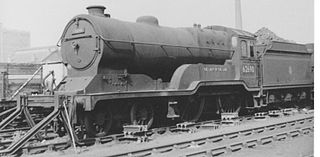
The Great Central Railway Class 11F or Improved Director Class is a class of 4-4-0 steam locomotive designed by John G. Robinson for passenger work. The LNER classified them as Class D11 from 1923. They were based on the earlier GCR Class 11E "Director" class.
Edward Thompson was an English railway engineer, and was Chief Mechanical Engineer of the London and North Eastern Railway between 1941 and 1946. Edward Thompson was born at Marlborough, Wiltshire on 25 June 1881. He was the son of an assistant master at Marlborough College. He was educated at Marlborough before taking the Mechanical Science Tripos at Pembroke College, Cambridge, earning a third class degree. Thompson's academic background contrasts with that of his predecessor Nigel Gresley, who had also attended Marlborough, but then gained practical experience as a pupil at Horwich Works.

The London and North Eastern Railway (LNER) Class B17, also known as "Sandringham" or "Footballer" class was a class of 4-6-0 steam locomotive designed by Nigel Gresley for hauling passenger services on the Great Eastern Main Line. In total 73 were built.

The London and North Eastern Railway Class U1 was a solitary 2-8-0+0-8-2 Beyer-Garratt locomotive designed for banking coal trains over the Worsborough Bank, a steeply graded line in South Yorkshire and part of the Woodhead Route. It was both the longest and the most powerful steam locomotive ever to run in Britain. It was built in 1925 with the motion at each end being based on an existing 2-8-0 design. The original number was 2395, and it was renumbered 9999 in March 1946, and then 69999 after nationalisation in 1948, although it retained its cab-side plate bearing its original number throughout its life. The locomotive ran for some time as an oil burner, and was tried out on the Lickey Incline in 1949–1950 and again, after the electrification of its home line, in 1955. These trials were unsuccessful, and so the locomotive was withdrawn in 1955 and scrapped.
Class (locomotive) refers to a group of locomotives built to a common design for a single railroad. Often members of a particular class had detail variations between individual examples, and these could lead to subclasses. Sometimes technical alterations move a locomotive from one class to another. Different railways had different systems, and sometimes one railway used different systems at different times and for different purposes, or applied those classifications inconsistently. Sometimes therefore it is not clear where one class begins and another ends. The result is a classic example of the Lumper splitter problem.

The Great Northern Railway (GNR) Class O2 was a class of three-cylinder 2-8-0 steam locomotives designed by Nigel Gresley for freight work and built by the GNR from 1921. Further examples were built by the London and North Eastern Railway (LNER) from 1924.
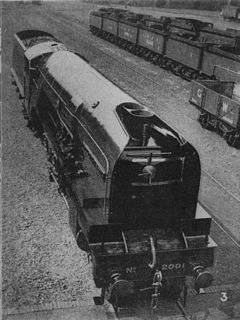
The London and North Eastern Railway Class P2 was a class of 2-8-2 steam locomotives designed by Sir Nigel Gresley for working heavy express trains over the harsh Edinburgh to Aberdeen Line. As they were to serve on Scottish expresses, they were given famous names from Scottish lore.

The LNER Class A1/1 consisted of a single 4-6-2 "Pacific" express passenger locomotive rebuilt in 1945 from an A1 class locomotive, by Edward Thompson. It was intended as the prototype of a new design of pacific locomotives improving the A4 design of Thompson’s predecessor Sir Nigel Gresley. No further examples were built due to Thompson’s retirement in 1946.
The North Eastern Railway (NER) Bogie Tank Passenger (BTP) locomotives were designed by Edward Fletcher in 1873. The locomotives were for hauling passenger services on branch lines. They had an 0-4-4 wheel layout and a total of 124 locomotives were built. They were designated G6 by the London and North Eastern Railway (LNER).
The London and North Eastern Railway (LNER) Class O6 was a class of 2-8-0 steam locomotives of the Stanier Class 8F type.
Willie Brayshaw Yeadon, was a British railway historian known for his magnum opus, Yeadon's Register of LNER Locomotives and other works.
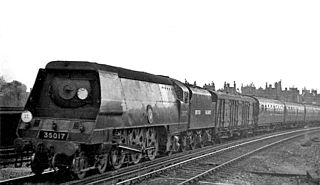
The 1948 Locomotive Exchange Trials were organised by the newly nationalised British Railways (BR). Locomotives from the former "Big Four" constituent companies were transferred to and worked on other regions. Officially, these comparisons were to identify the best qualities of the four different schools of thought of locomotive design so that they could be used in the planned BR standard designs. However, the testing had little scientific rigour, and political influence meant that LMS practice was largely followed by the new standard designs regardless. However, the trials were useful publicity for BR to show the unity of the new British Railways. To record the locomotive performances, one of three dynamometer cars were included in the consist directly behind the locomotive.
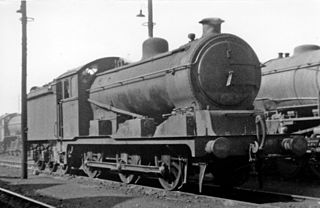
The GER Class D81 was a class of twenty-five 0-6-0 steam locomotives designed by A. J. Hill for the Great Eastern Railway. The all passed to the London and North Eastern Railway at the 1923 grouping and received the classification J20.

GCR Class 8B was a class of 25 two-cylinder steam locomotives of the 4-4-2 wheel arrangement built between 1903 and 1906 for the Great Central Railway. They were nicknamed "Jersey Lillies" after the famous music star Lillie Langtry.
The GNR Class J9 was a class of two-cylinder steam locomotives of the 0-6-0 wheel arrangement, built in 1896 for the Great Northern Railway.
This page is based on this
Wikipedia article Text is available under the
CC BY-SA 4.0 license; additional terms may apply.
Images, videos and audio are available under their respective licenses.
